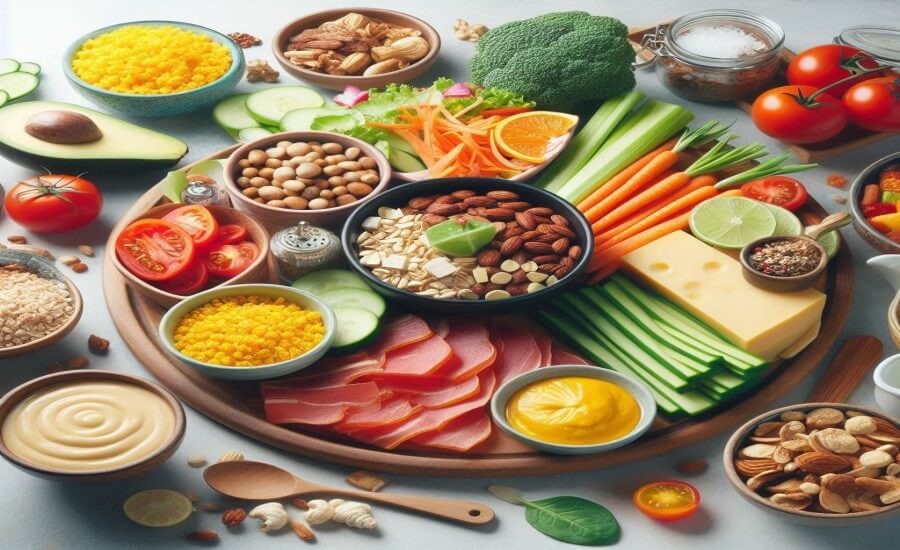A 7-day beginner vegan meal plan is far more than a simple dietary schedule; it’s a microcosm of the broader vegan movement and a potential entry point into a lifestyle with profound implications. This analysis examines such a plan through five distinct lenses: Nutritional Science, Ethical Advocacy, Environmental Science, Everyday Practice, and Cultural Observation. We find that while nutritionally sound veganism requires mindful planning (particularly for nutrients like B12, D, Iodine, and Omega-3s), it offers significant health benefits.
Ethically, it represents a stance against animal exploitation, aligning with growing concerns about animal welfare. Environmentally, shifting towards plant-based diets, as facilitated by such plans, offers substantial reductions in resource consumption and greenhouse gas emissions. From a practical standpoint, beginner plans aim to simplify the transition, addressing common challenges like meal prep and social navigation, though hurdles remain.
Culturally, the rise and promotion of such plans reflect evolving societal attitudes towards food, health, and sustainability, marking a shift in the mainstream food landscape. This multi-lens approach reveals the intricate web of factors surrounding even the simplest dietary change, highlighting its significance beyond the individual plate.
Why a Vegan Meal Plan?
LENS 1: Nutritional Analysis – Fueling the Body Plant-Style
- Key Findings: A well-structured beginner vegan meal plan can meet most macronutrient and many micronutrient needs, often increasing fiber, vitamin C, vitamin E, folate, potassium, and magnesium intake while lowering saturated fat and cholesterol compared to standard Western diets. However, careful attention must be paid to specific micronutrients that are often less abundant or bioavailable in plant foods.
- Detailed Analysis:
- Benefits: Increased intake of fruits, vegetables, legumes, and whole grains typically leads to higher fiber consumption, promoting gut health and potentially reducing the risk of chronic diseases like type 2 diabetes, cardiovascular disease, and certain cancers. Studies like the Adventist Health Study-2 have consistently shown associations between plant-based diets and lower BMI and reduced chronic disease risk.
- Nutrient Considerations:
- Vitamin B12: Not reliably found in plant foods; supplementation or fortified foods (nutritional yeast, plant milks, cereals) are essential. Deficiency can lead to irreversible neurological damage.
- Vitamin D: Primarily obtained through sun exposure or fortified foods/supplements, regardless of diet, but vegans may have lower intake if not mindful of fortified sources (plant milks, some mushrooms exposed to UV light).
- Omega-3 Fatty Acids (EPA/DHA): Plant sources primarily offer ALA (flax, chia, walnuts), which has a low conversion rate to the crucial EPA and DHA found in fatty fish. Algal oil supplements are a direct vegan protein source of EPA/DHA.
- Iron: Plant-based non-heme iron is less bioavailable than heme iron from animal sources. Pairing iron-rich foods (lentils, spinach, tofu) with Vitamin C sources (citrus, bell peppers) enhances absorption.
- Calcium: Found in leafy greens (kale, collards), fortified plant milks, tofu (set with calcium sulfate), tahini, and almonds. Absorption can be inhibited by oxalates in some greens like spinach.
- Iodine: Plant sources vary greatly depending on soil content. Iodized salt or seaweed (in moderation due to potential excess) or supplements are reliable sources.
- Vitamin B12: Not reliably found in plant foods; supplementation or fortified foods (nutritional yeast, plant milks, cereals) are essential. Deficiency can lead to irreversible neurological damage.
- The Role of the Meal Plan: A good beginner plan strategically incorporates fortified foods and nutrient-dense pairings to address these considerations, guiding users towards balanced intake without overwhelming them. It emphasizes variety within food groups.
- Benefits: Increased intake of fruits, vegetables, legumes, and whole grains typically leads to higher fiber consumption, promoting gut health and potentially reducing the risk of chronic diseases like type 2 diabetes, cardiovascular disease, and certain cancers. Studies like the Adventist Health Study-2 have consistently shown associations between plant-based diets and lower BMI and reduced chronic disease risk.
- Nutritional Deep Dive: Plant Protein Power
- The misconception that vegan diets lack sufficient protein is persistent. While individual plant foods might lack one or more essential amino acids (EAAs), consuming a variety of plant protein sources throughout the day (legumes, grains, nuts, seeds, tofu, tempeh) easily provides all EAAs. The concept of “protein combining” at every meal is outdated; daily variety suffices. A simple plan might include oatmeal with seeds for breakfast, lentil soup for lunch, and tofu stir-fry for dinner, demonstrating diverse protein sources.
- The misconception that vegan diets lack sufficient protein is persistent. While individual plant foods might lack one or more essential amino acids (EAAs), consuming a variety of plant protein sources throughout the day (legumes, grains, nuts, seeds, tofu, tempeh) easily provides all EAAs. The concept of “protein combining” at every meal is outdated; daily variety suffices. A simple plan might include oatmeal with seeds for breakfast, lentil soup for lunch, and tofu stir-fry for dinner, demonstrating diverse protein sources.
- Voice of Experience (Registered Dietitian): “A beginner vegan meal plan is a fantastic tool, if it’s well-designed. It demystifies nutrient needs and shows people it’s possible to eat satisfying, healthy vegan meals. The key is educating users why certain foods are included – highlighting B12 sources, iron-Vit C pairings, etc. – empowering them beyond the plan itself.” – Dr. Anya Sharma, RD.
- Hidden Benefit: Improved Gut Microbiome Diversity. High fiber intake from diverse plant sources feeds beneficial gut bacteria, potentially leading to improved digestion, immunity, and even mental health outcomes.
- Critical Reassessment: Over-reliance on highly processed vegan analogues (mock meats, cheeses) can undermine health goals. While useful transition tools, a sustainable, healthy vegan diet prioritizes whole or minimally processed plant foods, which a good beginner plan should emphasize.
LENS 2: Ethical Framework – A Plate of Principles
- Key Findings: Adopting a vegan meal plan, even for a week, is often rooted in or leads to ethical considerations regarding animal welfare, sentience, and the rejection of speciesism. It represents a conscious choice to minimize participation in systems perceived as exploitative.
- Detailed Analysis:
- Animal Welfare: Modern industrial agriculture (factory farming) raises significant ethical concerns regarding animal confinement, unnatural living conditions, painful procedures without anesthesia, and stressful transport/slaughter. A vegan meal plan directly avoids contributing demand to these industries.
- Sentience & Rights: Ethical veganism often stems from the belief that non-human animals are sentient beings capable of experiencing pain, pleasure, and suffering, granting them moral consideration or even basic rights (like the right not to be treated as property or resources). Philosophers like Peter Singer (utilitarianism) and Tom Regan (rights-based approach) have provided influential frameworks.
- Speciesism: This term, analogous to racism or sexism, describes prejudice or discrimination based on species membership. Ethical vegans argue that using animals for food, clothing, or entertainment simply because they are not human is an unjustified form of speciesism. Following a vegan meal plan is a practical application of rejecting this bias.
- Animal Welfare: Modern industrial agriculture (factory farming) raises significant ethical concerns regarding animal confinement, unnatural living conditions, painful procedures without anesthesia, and stressful transport/slaughter. A vegan meal plan directly avoids contributing demand to these industries.
- Voice of Experience (Animal Rights Advocate): “That first week trying a vegan meal plan can be transformative. It breaks the habit, the normalization of using animals. People realize they can live well without causing that harm, and often, the ethical reasons click into place more deeply once the practical barrier feels lower.” – Ben Carter, Sanctuary Founder.
- Daily Impact: Each meal chosen from the vegan plan becomes a small act of alignment with ethical values, potentially reducing cognitive dissonance for individuals concerned about animal suffering but previously unsure how to change their habits.
- Alternative Approaches: While many adopt veganism primarily for ethics, others arrive via health (“plant-based”) or environmental routes. The meal plan serves all, but the meaning attached to it differs. Some may practice “reducetarianism” or vegetarianism as steps along the way.
LENS 3: Environmental Scientist’s Analysis – Eating for the Planet
- Key Findings: Shifting towards plant-based diets, facilitated by tools like beginner meal plans, offers one of the most significant individual contributions to mitigating climate change, reducing land and water use, preventing deforestation, and protecting biodiversity.
- Detailed Analysis:
- Greenhouse Gas Emissions: Animal agriculture is a major contributor to GHGs, particularly methane (from enteric fermentation in ruminants like cows) and nitrous oxide (from manure and fertilizers used for feed crops). Plant-based foods generally have vastly lower carbon footprints. Major reports from the UN’s FAO and the IPCC highlight livestock’s significant impact.
- Land Use: A large percentage of global agricultural land is used for grazing or growing feed for livestock. Shifting to direct human consumption of plants is far more land-efficient, freeing up land for potential rewilding or ecosystem restoration. Research published in journals like Science quantifies this difference dramatically.
- Water Consumption: Producing animal products, particularly beef, requires significantly more water (for drinking, cleaning, and especially growing feed crops) than producing equivalent calories or protein from plants like legumes or grains.
- Biodiversity & Pollution: Clearing land for pasture and feed crops is a primary driver of habitat loss and biodiversity decline. Runoff from factory farms and fertilizer use pollutes waterways (eutrophication). Reducing demand via plant-based eating alleviates these pressures.
- Greenhouse Gas Emissions: Animal agriculture is a major contributor to GHGs, particularly methane (from enteric fermentation in ruminants like cows) and nitrous oxide (from manure and fertilizers used for feed crops). Plant-based foods generally have vastly lower carbon footprints. Major reports from the UN’s FAO and the IPCC highlight livestock’s significant impact.
- Market Transformation Map:
- This growth is partly fueled by easier entry points like meal plans and readily available alternatives, responding to consumer demand driven by health, ethics, and environmental awareness.
- This growth is partly fueled by easier entry points like meal plans and readily available alternatives, responding to consumer demand driven by health, ethics, and environmental awareness.
- Voice of Experience (Environmental Researcher): “Individual dietary shifts add up. While systemic change is crucial, widespread adoption of plant-centric diets, even starting with a simple week-long plan, sends market signals and directly reduces personal environmental footprints. It’s a powerful lever for change available to many.” – Dr. Lena Petrova, Climate Scientist.
- Hidden Benefit: Reduced Pesticide and Herbicide Load. Growing feed crops often involves intensive use of agrochemicals. Eating lower on the food chain can reduce indirect exposure and environmental contamination.
LENS 4: Everyday Practitioner’s Experience – Making it Work in Real Life
- Key Findings: While a beginner meal plan provides structure, the transition to vegan eating involves practical learning curves, potential social adjustments, and overcoming perceived barriers related to cost, convenience, and taste.
- Detailed Analysis:
- The Learning Curve: New ingredients (nutritional yeast, tempeh, chia seeds), cooking techniques, label reading (hidden animal products), and understanding basic nutrition become part of the initial experience. A good plan minimizes this by using accessible ingredients and simple recipes.
- Meal Prep & Time: Vegan cooking doesn’t have to be time-consuming, but like any dietary pattern focused on whole foods, some planning and preparation (e.g., cooking grains/beans in batches, chopping vegetables) can be beneficial. The meal plan aims to structure this.
- Cost: While specialty vegan products can be expensive, a diet based on staples like beans, lentils, rice, potatoes, seasonal vegetables, and oats can be very budget-friendly. The meal plan’s design heavily influences cost perception.
- Social Dynamics: Eating out, attending gatherings, or navigating family meals can present challenges. This often requires communication, planning ahead (checking menus, bringing a dish), and developing polite responses to questions or skepticism.
- Taste & Satisfaction: Taste preferences can adapt. Initially, some may miss familiar flavors or textures, but exploring new spices, herbs, and cooking methods often leads to discovering a rich and satisfying plant-based cuisine. The meal plan should offer flavorful, appealing dishes.
- The Learning Curve: New ingredients (nutritional yeast, tempeh, chia seeds), cooking techniques, label reading (hidden animal products), and understanding basic nutrition become part of the initial experience. A good plan minimizes this by using accessible ingredients and simple recipes.
- Voice of Experience (Recent Vegan Transitioner): “The 7-day plan was my lifeline! It took the guesswork out. Yeah, the first trip to the grocery store took longer, reading labels. And explaining to my family was awkward at first. But having the plan meant I always knew what I could eat, and the food was surprisingly tasty. It made me realize it was doable.” – Sarah Chen, Graphic Designer.
- Daily Impact: Learning to stock a vegan pantry, finding go-to simple meals beyond the plan, discovering local vegan-friendly spots, and building confidence in social situations are key outcomes of successfully navigating the initial period.
LENS 5: Cultural Observer’s Perspective – Veganism in the Social Fabric
- Key Findings: The proliferation of beginner vegan meal plans signifies a broader cultural shift where veganism is moving from a niche counter-culture to a more visible, accessible, and even trendy lifestyle choice, influencing food industries, media, and social norms.
- Detailed Analysis:
- Historical Context: While modern Western veganism is relatively recent (The Vegan Society founded in 1944), many cultures have long traditions of plant-centric or entirely plant-based eating (e.g., Jainism in India, Ital Rastafarianism, certain Buddhist traditions, historically peasant diets globally). The current trend reconnects with and sometimes repackages these traditions.
- Mainstreaming & Commodification: Veganism’s increased visibility is evident in supermarkets stocking numerous alternatives, chain restaurants offering vegan menus, celebrity endorsements, and extensive online resources (blogs, social media influencers promoting meal plans). This mainstreaming also involves commercialization.
- Media Portrayal: Documentaries (e.g., “What the Health,” “Cowspiracy,” “The Game Changers”) have significantly impacted public perception, driving interest in veganism and related meal plans. Media narratives shape understanding and motivation.
- Social Identity & Community: For some, adopting a vegan lifestyle becomes part of their social identity, fostered by online and offline communities that share recipes, support, and reinforce shared values. Meal plans can be an entry point into these communities.
- Cultural Resistance: Despite growing acceptance, veganism can still face resistance, being perceived as extreme, inconvenient, or a rejection of cultural/family traditions centered around animal products.
- Historical Context: While modern Western veganism is relatively recent (The Vegan Society founded in 1944), many cultures have long traditions of plant-centric or entirely plant-based eating (e.g., Jainism in India, Ital Rastafarianism, certain Buddhist traditions, historically peasant diets globally). The current trend reconnects with and sometimes repackages these traditions.
- Voice of Experience (Sociologist of Food): “These beginner meal plans are cultural artifacts. They signal that veganism is now considered ‘try-able’ by the mainstream. They simplify entry, package it conveniently, and reflect a confluence of health trends, ethical consumerism, and environmental consciousness that’s reshaping our food landscape.” – Dr. David Miller, Sociologist.
- Turning Point Analysis:
- Early 2000s: Rise of online vegan communities and blogs sharing recipes and information.
- Mid-2010s: Release of influential documentaries coinciding with significant venture capital investment in plant-based food tech (e.g., Beyond Meat, Impossible Foods).
- Late 2010s-Present: Major fast-food chains launching vegan options globally, signifying widespread market viability and cultural acceptance. The proliferation of accessible meal plans fits this stage.
PERSPECTIVE INTERSECTION MATRIX
- Nutrition <> Ethics: Understanding that humans can thrive nutritionally on plants (Lens 1) removes a key barrier to adopting an ethically motivated vegan diet (Lens 2). Conversely, ethical motivations drive individuals to seek out nutritionally sound vegan information.
- Environment <> Practice: Awareness of the environmental impact (Lens 3) can motivate individuals to overcome the practical hurdles (Lens 4) of adopting a vegan diet, using tools like meal plans. Market growth driven by environmental concerns makes vegan options more practically accessible.
- Ethics <> Culture: Growing ethical concern for animals (Lens 2) fuels the cultural shift (Lens 5) towards veganism, leading to greater availability of resources like meal plans. Cultural normalization reduces the social friction (Lens 4) sometimes associated with ethical stances.
- Nutrition <> Practice: Practical challenges like time or cost (Lens 4) can impact the ability to adhere to a nutritionally optimal vegan diet (Lens 1). Well-designed, practical meal plans bridge this gap.
- Culture <> Environment: Cultural trends embracing sustainability (Lens 5) amplify the message about the environmental benefits (Lens 3) of plant-based eating, driving further adoption.
MISCONCEPTION ANALYSIS
| Misconception | Reality (Drawing from Lenses) |
| Vegan diets lack sufficient protein. | Variety of plant sources throughout the day easily provides all essential amino acids. (Lens 1: Nutrition) |
| It’s impossible to get enough B12. | B12 must be obtained from fortified foods or supplements, which are readily available and effective. This requires conscious inclusion, guided by a good plan. (Lens 1: Nutrition) |
| Vegan food is bland and boring. | Plant-based cuisine is incredibly diverse, flavorful, and satisfying, utilizing global culinary traditions and modern innovations. Taste adapts. (Lens 4: Practice, Lens 5: Culture) |
| Being vegan is expensive. | While specialty products can be costly, a diet centered on whole food staples (beans, lentils, grains, seasonal produce) is often more affordable than meat-heavy diets. (Lens 4: Practice) |
| Veganism is nutritionally risky/unhealthy. | Well-planned vegan diets are recognized as nutritionally adequate and healthful for all life stages by major dietetic associations, offering many health benefits. (Lens 1: Nutrition) |
| Veganism leads to social isolation. | While challenges exist, growing acceptance and online/offline communities offer support. Communication and planning help navigate social situations. (Lens 4: Practice, Lens 5: Culture) |
| Individual diet changes don’t impact the environment. | Collective individual shifts significantly reduce demand for resource-intensive animal products, lessening GHG emissions, land/water use, and pollution. (Lens 3: Environment) |
KEY TURNING POINTS (Revisited)
- Founding of Vegan Societies (e.g., UK 1944): Formalized the definition and philosophy, distinguishing it from vegetarianism.
- Publication of Influential Ethical Texts (e.g., Singer’s Animal Liberation 1975): Provided strong philosophical grounding for the movement.
- Rise of the Internet & Social Media (Late 90s-Ongoing): Enabled global community building, information sharing, recipe dissemination, and the rise of influencers, making veganism more accessible and visible.
- Key Documentary Releases (2010s): Films like Forks Over Knives, Cowspiracy, What the Health, and The Game Changers reached mass audiences, popularizing health, environmental, and ethical arguments.
- Venture Capital & Food Tech Innovation (Mid-2010s onwards): Investment fueled realistic plant-based meat/dairy alternatives, lowering barriers for mainstream consumers.
- Mainstream Fast Food Adoption (Late 2010s onwards): Signaled broad market acceptance and made vegan options ubiquitously convenient. Beginner meal plans are a product of this normalization phase.
SYNTHESIS & RECOMMENDATIONS
A simple 7-day beginner vegan meal plan is a nexus point where personal health choices intersect with profound ethical considerations, significant environmental impacts, practical daily realities, and ongoing cultural shifts. It’s a tool that simplifies entry into a lifestyle, but its true value lies in representing these interconnected dimensions.
- For Individuals: View the meal plan not just as recipes, but as a structured experiment. Pay attention to nutritional guidance (especially B12), embrace the learning process, explore flavors, and reflect on your motivations across the different perspectives.
- For Plan Creators: Emphasize whole foods, provide clear nutritional information (especially for critical nutrients), offer practical tips beyond recipes (shopping, social), and acknowledge the ethical/environmental context.
- For Society: Recognize the growing interest in plant-based eating, driven by diverse factors. Support access to affordable, healthy plant-based options and foster informed dialogue about our food systems’ multifaceted impacts.
Ultimately, engaging with a vegan meal plan, even briefly, offers a unique opportunity for multi-dimensional learning – about food, health, ethics, the planet, and oneself.












